It's a whole new world down
there...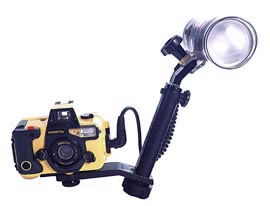
Ever since a fellow traveller lent me his snorkel mask in Fiji and I first popped my head below the surface and into a whole different underwater universe, I've been hooked on diving. Whilst working in Hong Kong I was lucky enough to go on two diving trips to the Philippines. On the second trip, after a fruitless attempt to rent an underwater camera, a friend kindly lent me his Sea & Sea Motormarine kit (pictured right). Underwater photography with a camera like this is tricky. Focus, aperture and shutter speed are all set manually. As an added challenge the camera's exposure meter wasn't working!
Underwater kit
Obviously you need a camera. Less obviously, you need a strobe, unless you are only interested in taking available light pictures like the one on the right. Even less obviously, you need a dive computer. Underwater photography using a relatively sophisticated camera like the Motormarine is a VERY involved activity, and you won't have time to think about your dive profile. I would SERIOUSLY recommend against attempting any vaguely serious underwater photography without a dive computer. I tried to hire an underwater camera soon after I'd qualified as a PADI Open Water diver in Australia a few years ago. Fortunately I wasn't able to find one, as I'd probably have killed myself. I would recommend having done at least 20 dives before attempting to dive with a camera.
Types of Camera
1) The useless
Starting with the least sophisticated and cheapest option, there are disposable cameras. These are largely useless for taking pictures of fish whilst diving, although they are quite fun to muck about with taking photos of your mates near the surface. They are really intended as indestructible cameras for use on the beach or for snorkelling, and are only rated to survive to a depth of 10 metres. Taking one on a dive would be a bad idea.
Next there are 35mm and APS compact cameras which can be used underwater up to 5 - 10 metres. These are also rubbish for taking pictures of fish. Above water, they are autofocus cameras, but below the surface they become fixed focus. This means if you get a fish close enough to fill the frame, it will be out of focus. If it is far enough away to be in focus, it will be tiny and not very colourful.
2) The vaguely decent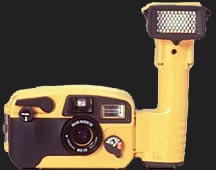
The next step up is something like the Sea & Sea MX10. This is a "proper" underwater camera, rated to 45 metres, so unlike the others mentioned so far you can actually take it on a dive to normal depths without it imploding. Unfortunately it is still fixed focus so although there is potential for reasonable results you won't be able to achieve critical sharpness.
3) Decent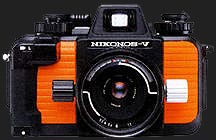
The Sea & Sea Motormarine, pictured at the top of the page, is the
next step up. It has manual focus, aperture and shutter speed selection,
and a strobe with TTL exposure metering. More expensive but similar is
the Nikonos which is also a manual focus 35mm camera. The Nikonos is probably
the most popular underwater system. The main difference from the Motormarine
is that although the Nikonos has interchangeable lenses, the lenses can't
be changed underwater. The Motormarine has a fixed lens but wide angle
and close-up lenses can be attached to the front of the normal lens whilst
you are underwater. The Nikonos lenses are probably of superior optical
quality, but you are only ever going to be able to take advantage of that
if you focus-guessing skills are supreme, as neither camera has any aid
to focusing.
4) The best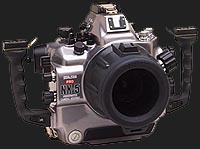
The main disadvantage of the Motormarine and Nikonos is that focusing is done by guesswork. For really critically sharp photos, you need an SLR. Nikon used to make an underwater SLR, but it is no longer in production. Instead you have to use a normal SLR in an underwater housing. These are bulky and expensive, and only available for certain models of camera.
The housing shown is the Sea & Sea NX5, for the Nikon F5.
5) Digital?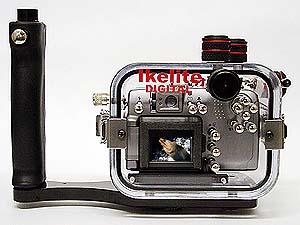
The future of underwater photography is undoubtably digital, and housings are already available for a number of normal digital cameras. I do not know of a dedicated underwater digital camera which doesn't require a housing, but perhaps someone could correct me if I'm wrong.
Digital cameras are able to work in low light without the grain associated with using fast film in film cameras. There is a very high failure rate with underwater photography, and another massive advantage of digital is that you can simply delete the failures without any waste of film. This could potentially be done underwater, avoiding the nightmare experienced by users of film cameras when a whale shark shows up at the end of a dive after the film is finished!
The Photo shows a Canon G2 digital camera in an Ikelite housing.
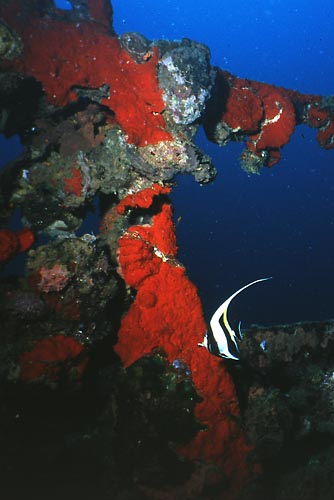 Film
Film
Assuming you don't go for digital, the next thing you need is some film. My fear was that I would come back from the trip without a single decent image. One of my cunning plans for avoiding this fate was to use two different types of film. 100 ASA Slide film (Fuji Sensia) and 400 ASA colour print film (Fuji Superia).
My theory was that the much greater exposure latitude of the colour print film, together with its faster speed, would help make sure I got some images. The faster film speed would mean I could use smaller apertures giving greater depth of field and more chance of getting things in focus.
In fact all the best images were from the slide film. Although underwater exposure is tricky, it turned out that, for me and with that camera at least, I never overexposed a single shot. Underexposure, on the other hand, was common. You're always struggling to get enough light, even when using the strobe. The image on the left shows the rich, saturated colours acheived by using 100ASA slide film in combination with the strobe. Slide film can handle a reasonable amount of underexposure - colours become more saturated and shadow detail is lost but the results are more acceptable than underexposed print film which quickly becomes a grainy, washed-out mess.
| [Home] | [About] | [Order Prints] | [Articles] | [Links] |